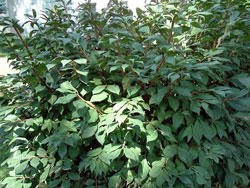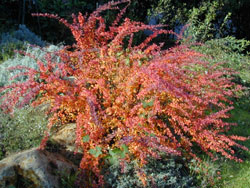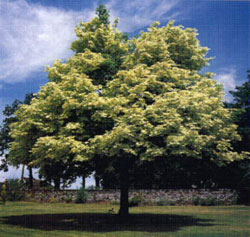Invasive Plants
Invasive plants are non-native species that spread into an intact ecosystem and cause economic or environmental harm by developing self-sustaining populations and becoming dominant or disruptive to those systems. They are replacing native plants in many forests and fields throughout our region. Invasive plants are degrading wildlife habitat, impairing forest health and productivity and reducing biodiversity. In 2004, the Invasive Species Committee identified 18 species to be prohibited from sale, transport, distribution, propagation or transplantation in New Hampshire.
This page contains information about 3 more species that were prohibited as of January 1, 2007.
More information about identification and eradication of non-native invasive plants may be found on the following websites:
Burning Bush
Euonymus alatus
 Burning Bush was introduced into the United States from
northeastern Asia around 1860 for use as an ornamental shrub.
The bright red fall foliage makes this shrub a popular ornamental
planting and it is commonly planted along interstate highways,
as hedges, and in foundation plantings. While it behaves
well in urban areas, Burning Bush planted near woodlands,
mature second-growth forests and pastures can be problematic.
It has been observed escaping from cultivation in the northeast
and is a threat to woodland areas, fields and coastal scrubland
because it outcompetes native species.
Burning Bush was introduced into the United States from
northeastern Asia around 1860 for use as an ornamental shrub.
The bright red fall foliage makes this shrub a popular ornamental
planting and it is commonly planted along interstate highways,
as hedges, and in foundation plantings. While it behaves
well in urban areas, Burning Bush planted near woodlands,
mature second-growth forests and pastures can be problematic.
It has been observed escaping from cultivation in the northeast
and is a threat to woodland areas, fields and coastal scrubland
because it outcompetes native species.
Alternatives:
- American cranberrybush viburnum
- Highbush blueberry
- Redvein enkianthus
- Fothergilla
- Red chokeberry
Management:
- Hand remove seedlings and saplings. Use a spade or shovel to dig out larger plants. Large populations may be controlled with herbicide use.
Japanese Barberry
Berberis thunbergii
 Japanese Barberry is widely grown as an ornamental plant,
both in Japan and elsewhere in the temperate Northern Hemisphere.
Numerous cultivars have been selected, including plants selected
for yellow, dark red to violet, or variegated foliage, erect
growth (for hedge use) and dwarf size. In recent years it
has become an invasive species in parts of the eastern United
States.
Japanese Barberry is widely grown as an ornamental plant,
both in Japan and elsewhere in the temperate Northern Hemisphere.
Numerous cultivars have been selected, including plants selected
for yellow, dark red to violet, or variegated foliage, erect
growth (for hedge use) and dwarf size. In recent years it
has become an invasive species in parts of the eastern United
States.
Alternatives:
- Weigela
- Slender deutzia
- Common ninebark
- Shrub roses
Management:
- Remove small immature plants by hand. Dig larger plants with a garden spade or weed wrench. Cut or mow stems repeatedly at base or control with herbicide treatment.
Norway Maple
Acer platanoides
 Norway Maple is a deciduous tree native to Europe and the
Near East. It has dense foliage and reaches to 60-70 feet.
Leaves are 5-lobed, 3-5 inches wide, and are deep green.
They turn a bright yellow in the fall and showy clusters
of small, greenish-yellow flowers appear in early spring.
Norway Maple is a deciduous tree native to Europe and the
Near East. It has dense foliage and reaches to 60-70 feet.
Leaves are 5-lobed, 3-5 inches wide, and are deep green.
They turn a bright yellow in the fall and showy clusters
of small, greenish-yellow flowers appear in early spring.
Alternatives:
- Red maple
- Northen red oak
- Gingko
- Japanese tree lilac
- European beech
- Flowering crabapple (Malus species)
- Plum and Cherry (Prunus species
Management:
- Hand pull seedlings. Slash bark and apply herbicide to wounds.

